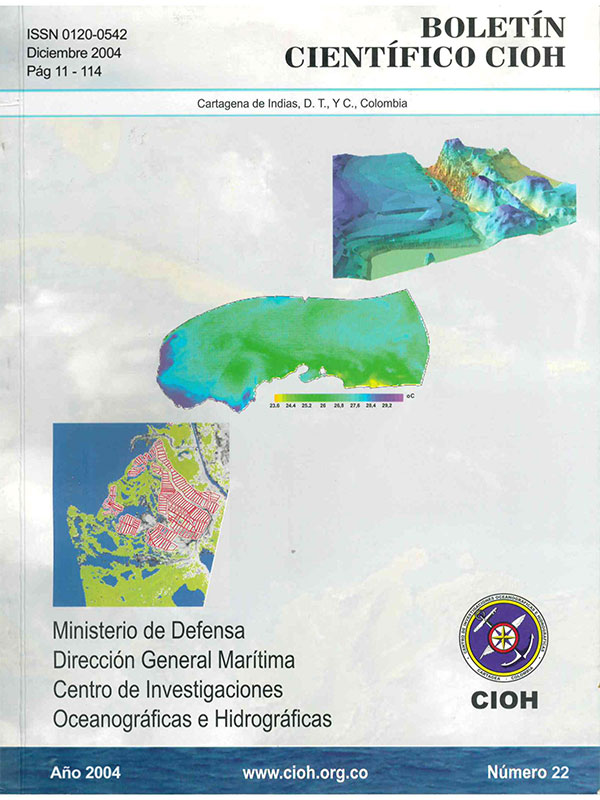Aspectos morfodinámicos de la bahía de Cartagena de Indias
DOI:
https://doi.org/10.26640/22159045.131Palabras clave:
Geodinámica Bahía de Cartagena, Mar CaribeResumen
Se analizan los cambios de la profundidad ocurridos recientemente (un siglo) en los fondos de la bahía de Cartagena mediante la comparación de los levantamientos batimétricos de los años 1935, 1987 y 2004. También se caracteriza y analiza la distribución de los sedimentos de la bahía en su parte externa e interna. Los resultados muestran que los sedimentos de la parte interior deben su repartición y origen a dos estructuras antrópicas, la Escollera de Bocagrande y el canal del Dique. Los sedimentos del Dique ya han ocupado las partes que eran arenosas de los fondos hace pocos años y su delta ha avanzado más de un kilómetro hacia el Norte, comprometiendo la profundidad del canal navegable de acceso a Bocagrande y la bahía interna de Cartagena.
Descargas
Referencias
Andrade, C., Arias F., y Thomas, Y. (1988). Nota sobre la turbidez, circulación y erosión en la región de Cartagena (Colombia). Boletín Científico CIOH, No. 8, Cartagena, pp. 71-81.
Armstrong M. & Carignan J. (1997). Géostatistique linéair : application au domaine minier. Paris : Les Presses de l'école des Mines. 112 p.
Berlinsky, N.A. and Lonin, S.A. (1997). Assessment of the intensity of litodynamic processes in the vicinity of the port of Ust-Dunaisk, Physical Oceanography, Vol. 8, N.2, pp. 135-142. - Abstract: Oceanographic Literature Review, Vol. 44, Issue 9, Sept. 1997, page 944.
Díaz J. J. (2003). Ajuste y comparación de cartas, mapas y planos de los siglos XVIII y XIX. Boletín Científico del CIOH, No. 21, Cartagena, pp. 134-139.
Gratton Y. (2002). Le krigeage : la méthode optimale d'interpolation spatiale. Les articles de l'Institut d'Analyse Géographique : http://www.iag.asso.fr.
Holthuijsen, L.H., Booij N. et. al. (2003). SWAN User Manual: SWAN Cycle III version 40.20. Delft, Netherlands, Faculty of Civil Engineering and Geosciences, Environmental Fluid Mechanics Section, Delft University of Technology, 128 p. Matheron G. (1970). La théorie des variables régionalisées et ses applications. Les Cahiers du Centre de Morphologie Mathématique de Fontainebleau, 212 p.
Lesueur P. y Vennete J. G. (1981). Procesos de Erosión en la Playa de Manzanillo. Boletín Científico CIOH, No. 3., Cartagena, pp. 55-72.
Lonin S., Parra C., Thomas Y-F., Andrade C. (2004). Patrones de la pluma turbia del canal del Dique en la bahía de Cartagena. Boletín Científico CIOH, No. 22, Cartagena, (presente Boletín)
Lonin, S.A. (2002). Un modelo morfodinámico para la zona costera del Caribe colombiano. Boletín Científico CIOH, No. 20, Cartagena, pp. 5-17.
Lonin, S.A., y L.A. Mendoza (1997), Evaluación Hidrodinámica de las Bahías Hooker e Icacos, Boletín Científico CIOH, No. 18, Cartagena, pp. 51-64.
Pagliardini J. L., Gómez M. A., Gutiérrez T., Zapata D. S., Jurado R. A., Garay J. A., Venette G. Síntesis del Proyecto Bahía de Cartagena. Boletín Científico CIOH. No. 4. Cartagena, pp. 49-110.
SWAN (1999). User Manual (not the short version), SWAN Cycle 2 version 40.01, 107 pp.
Thierry B. & Vernette, J. G. (1982). Huellas de la Ultima Transgresión Marina en la Región de Cartagena. Boletín Científico CIOH, No. 4. pp. 39-47.
Urbano J., Thomas Y. F., Parra C., Genet P. Y. (1992). Dinámica de la Turbidez del Canal del Dique en la Bahía de Cartagena. Boletín Científico CIOH, No. 11, Cartagena, pp. 3-14.
Van Rijn, Leo C. (1993). Principles of Sediment Transport in Rivers, Estuaries and Coastal Seas. Aqua Publ. I11.
Vernette, J. G., Buitrago, N., Campos y Llano M. (1977). Variación Morfológicas de las Costas de la Bahía de Cartagena a partir del Siglo XVI. Boletín Científico CIOH. No. 1, Cartagena, pp. 20-39.
Vernette, J. G., y Klingebiel A. (1979). Estudio Batimétrico y Sedimentológico en la Plataforma Continental entre Cartagena y la Desembocadura del Río Magdalena. Boletín Científico CIOH, No. 2, Cartagena, pp. 55-70.
Vernette, J. G., Lesueur P. y Klingebiel A. (1984).
Descargas
Publicado
Número
Sección
Licencia
Reconocimiento — Debe reconocer adecuadamente la autoría, proporcionar un enlace a la licencia e indicar si se han realizado cambios<. Puede hacerlo de cualquier manera razonable, pero no de una manera que sugiera que tiene el apoyo del licenciador o lo recibe por el uso que hace.
NoComercial — No puede utilizar el material para una finalidad comercial.
SinObraDerivada — Si remezcla, transforma o crea a partir del material, no puede difundir el material modificado.
No hay restricciones adicionales — No puede aplicar términos legales o medidas tecnológicas que legalmente restrinjan realizar aquello que la licencia permite.



